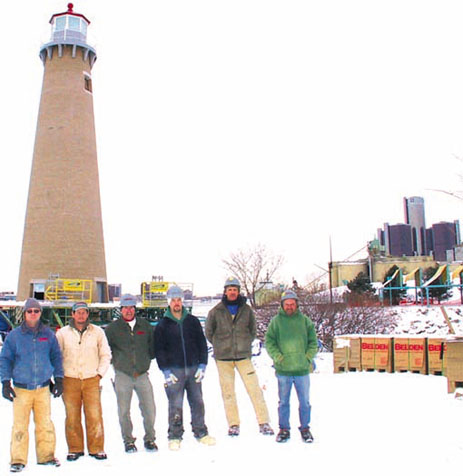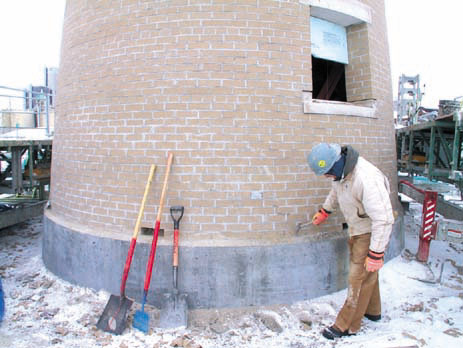Bricklayers rediscover lost art of lighthouse construction
Date Posted: February 20 2004
It looks like a lighthouse. It was modeled after a lighthouse. But the U.S. Coast Guard prefers that we don’t call it a lighthouse.
We’re going call it a lighthouse, anyway.
Construction wrapped up last month on the 58-foot-tall “Harbor Entry Safety Light,” built in Detroit’s Tricentennial Park at the foot of St. Aubin Street and the Detroit River. A crew of Davenport Masonry masons took nearly three months to erect the lighthouse, which was built as a decorative element rather than a navigation aid – hence the distinction by the Coast Guard.
Even as a decorative element, it’s impressive.
“This is way out of the ordinary, I never did anything like this before in my life,” said Davenport Masonry foreman Mike Piazza, who talked to us on one of the last days of the project. “Normally, we deal with level surfaces. But here there was no frame, anchors or reference points to work with. Just circular courses of brick and mortar. The work is tedious. But it did turn out beautiful.”
The lighthouse is roughly modeled after the 70-foot-tall Tawas Point Lighthouse on Lake Huron, which was built in 1876. Pat Roach, the project architect for the Smith Group, said the Tawas Point light was considered by the state DNR to be an “iconic Michigan lighthouse,” and thus a good candidate for reproduction.
The lighthouse will be the focal point in the 31-acre Tricentennial Park, which was named for Detroit’s 300th birthday in 2001. The project includes a marina and is part of the $500 million, three-mile long RiverWalk project in Detroit, which extends from Hart Plaza to the Belle Isle Bridge. Dan’s Excavating is acting as general contractor on the state park, the state’s first to be constructed in an urban setting.
The Detroit lighthouse has a base circumference measurement of 16 feet, tapering with a five-degree vertical slope to an eight-foot circumference at the top.
While some smaller replica lighthouses have been built on the Great Lakes – and some beacons have been rebuilt – it appears that their construction is a lost art.
According to the National Park Service, the oldest surviving lighthouse in Michigan is the brick Fort Gratiot light, built in 1829 in St. Clair County. The most recently built lighthouse used for navigation and not decoration, is the Round Island Light near Mackinac Island, constructed in 1948.
“Building a lighthouse is a first for us, and I guess I don’t know of anybody who is alive who has ever built one this size,” said Kyle Lochonic, project manager for Davenport Masonry.
The bricklaying work on the Detroit lighthouse proceeded during some brutally cold weather on the river. Piazza said a wood wedge taped to a mason’s level provided the proper angle “so we could see the bubble” to allow for the tapering of the walls as the courses of brick were laid. The bricks are a common rectangular shape. A slight amount of “play” in mortar from course to course was also utilized to shape the lighthouse’s brick walls, Piazza said.
Installing the masonry frame for the rectangular door was also a challenge, Piazza said. “We don’t think twice about building a brick doorway in a square building,” he said. “But try putting a square doorway in a round building. We had to do some thinking on that one.”
Last month, the hollow interior of the lighthouse included an incomplete steel structure that will provide anchorage points for the masonry walls. The interior will not be open to the public, and there is certainly no room for a keeper. A ladder will allow maintenance access to the lantern house and the observation area atop the lighthouse.
The specifications on the light, Roach said, were made in consultation with the Coast Guard. They settled on the installation of three 39-watt metalhalide lamps, “which creates some sparkle up there, but isn’t bright enough that any boaters will confuse us with Belle Isle,” Roach said.
If you want a lighthouse of your own, the cost came in under half a million dollars.
“It’s an example of good, old-fashioned, solid load-bearing masonry, but there’s no doubt, it’s an unusual project,” Roach said. “All in all, this went better than I expected. Davenport is an experienced and well-qualified contractor and they did a good job.”

THE CREW who helped erect the Detroit lighthouse include (l-r) foreman Mike Piazza, Don Locker, Lee Felty, Brian Gardner, Carl Portels and Robert Terbush. Not in the photo are Doug Burnett and Terry Bennett.

BRICKLAYER Don Locker chips away excess mortar at the base of the lighthouse.
